Sansui 1000A
|

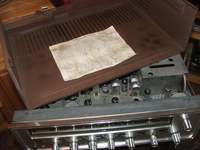
 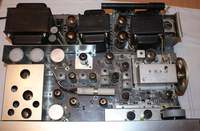
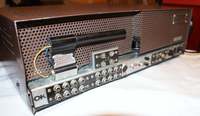  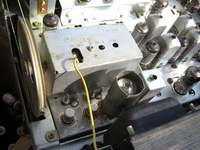 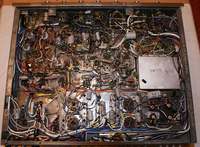
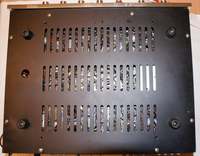 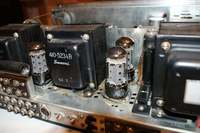 f f
|
Competition
from the Japanese islands sought to repeat the success of
1000A. Pioneer produced the SX-110 on 7868 tubes (that's
7591 with a different base), Kenwood sold the KW-1100
on 7591 tubes. But that was in small numbers compared to
the 1000A. It is the most frequently offered non-American
receiver at auctions, which proves how many copies of this
device were purchased in the 1960s and early 1970s. Sansui 1000A weighed 22 kg (!!!). Its dimensions are: width 46.5 cm, height 14 cm (plus the legs), depth 26 cm. Model 1000A had a "design" in the style of the late 1960s and the front inherited from the 1000 model made of thick aluminum with a symmetrical structure; switches on one level, potentiometers on the other. The top is a scale with pointers and a "wave" knob. The receiver had a beautifying and mounting element - a stylish "vintage" nickel-plated steel frame around the front panel. Mounting - because this equipment could be installed in consoles or walls. This look (except for the frame) is the pattern for the next 25 years. Even at the beginning of the 90s, equipment was produced that was very similar in appearance. 1000A had very extensive signal inputs as well as large adjustment possibilities and various types of switches / filters. Bass and Soprano controls - each of the functions had separately adjustable potentiometers on one axis (left and right channel can be adjusted separately), the inner knob is the right channel, and the outer knob is the left channel. The "MODE" switch - the type of operation made it possible to switch between channels - mono with the signal from the left channel only, the right one too, changing channels, etc. (today no company uses such switching, but it was of great importance then, many signal sources it was mono). "BAND SELECTOR" switch - four positions - narrow and wide AM reception (in the 1960s medium wave was very important in the lives of young people) and mono / stereo FM. "SELECTION" switch, i.e. signal selection - microphone, tape heads, 2 x turntable, 2 AUX inputs, tape recorder and internal tuner. Filter switches: high-cut (cuts the treble), low-cut (cuts the bass), loudness and a filter called "presence" - boosts low tones. In addition, MUTE, automatic frequency control and speaker switch (to listen on headphones) are standard only in the best equipment at the time. To enjoy 1000A you need the right speakers and space. Such a large number of knobs on the front (8 in total) makes an impressive impression and it is difficult to confuse 1000A with other equipment. The power of 2 x 40 W was given as power in sine, the music power was 55 W per channel. There were reportedly ten versions of the receiver. I was able to identify three elements that distinguished these versions (but there could have been more changes - e.g. changes to the chassis construction):
Sansui 1000A also has a lot of tubes on board as it was a large device - 21 in total. 19 were visible, and the other two were tiny nuvistors in the FM head. Unlike American companies, the Japanese supplied their products with original, not "branded" lamps. 1000A were sold with Japanese-made lamps from Matsushita, Nec, Hitachi and Toshiba. The latter two supplied power tubes 7591 with the letter "A" - a higher rated. They had to be like that if they were to deliver 40 W of power on one channel. The driver tubes 6AN8 were the favorites of the designers from the islands. Apart from them, the 12AX7 / ECC83 preamplifier also worked in the preamplifier. The correction preamp for a magnetoelectric turntable and a microphone was a construction based on a total of 4 germanium transistors. Such a solution was characteristic for Sansui. The FM head was shared with the 500A model and the TU-70 tuner. One of the best designs in this segment in those years. Two 6CW4 nuvistors tubes worked with one 6AQ8 / ECC85 to ensure excellent sensitivity and separation. The intermediate frequency path was also not economical and had a total of 4 tubes 6BA6 / EF93 and 6AU6 / EF94. The MPX decoder on a PCB with three tubes 6AQ8 / ECC85, 6BL8 / ECF80 and 12AU7 / ECC82 provided good stereo separation and automation with weaker signals. A neon tube was used as a stereo indicator, but its operation was not very precise. The tuning could be observed on a small pointer dial indicator was illuminated in white while the tuner worked. The FM range was standard 88-108MHz and AM was 535-1605KHz medium wave. The receiver was powered by a voltage doubler based on silicon diodes. The Sansui 1000A, standing next to modern devices, looks impressive, few speakers are able to cope with it, and hardly anyone can manipulate this device. And importantly - do not put it on the shelf in the wall unit - these are not compatible technologies. |
